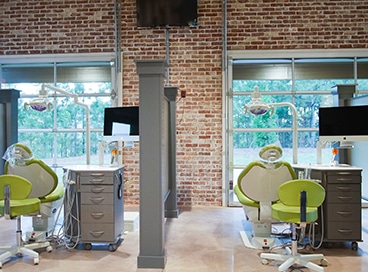The Definitive Guide to Orthodontics
The Definitive Guide to Orthodontics
Blog Article
What Does Orthodontics Do?
Table of ContentsOrthodontics Fundamentals ExplainedOrthodontics for Dummies5 Easy Facts About Orthodontics ExplainedOrthodontics Things To Know Before You BuyOrthodontics Fundamentals ExplainedThe Only Guide to OrthodonticsThe Greatest Guide To Orthodontics
You may really feel some discomfort for some time when your dental braces are first placed on and when they are changed (Orthodontics). It will certainly take a little time to get utilized to your dental braces and they can bother your lips and cheeks. If this occurs, a relief wax can be used to your dental bracesIt is vital to brush your dental braces as well as the front, back and eating surface areas of the teeth. Your dental professional or orthodontist will offer you ideas on how to comb and on just how to floss utilizing floss threaders. After flossing, roll it up in a little round and put it in the garbage.
The Basic Principles Of Orthodontics
Moms and dads must supervise their kids to make certain they do a great job cleaning their teeth and braces and follow the suggestions of their dental practitioner or orthodontist. If you have dental braces, do not attack on tough points such as ice cubes and nuts. Do not eat completions of pens or pencils.

It guides the direction of tooth motion and jaw development in someone who is still expanding. There are various kinds of headwear and they may be put on throughout any kind of part of the orthodontic treatment. Your orthodontist or dental expert will reveal you just how to put on the headwear and tell you the length of time to use it daily.
Indicators on Orthodontics You Should Know
They may require to be put on regularly or part of the moment. Tooth elimination may be needed if your teeth are crowded or if a tooth is severely out of position. Jaw surgery (or orthognathic surgical treatment) might be needed when there are major differences in the size or placement of the top and lower jaws.
An orthodontist is a dental expert educated to identify, protect against, and treat teeth and jaw irregularities. Orthodontists work with individuals of all ages, from children to grownups.
Orthodontic residency programs provide extensive, focused instruction for oral professionals. They concentrate on two areas: Just how to correctly and securely relocate teeth Just how to properly direct growth in the teeth, jaw, and faceOnce an orthodontist has finished training, they have the choice to come to be board accredited.
The Main Principles Of Orthodontics
Misalignment, or malocclusion, is one of the most common factor individuals see an orthodontist. It is hereditary and is the result of dimension distinctions between the top and reduced jaw or in between the jaw and teeth. Malocclusion causes tooth congestion, an irregular jaw, or uneven bite patterns. Continued Orthodontics. Malocclusion is normally treated with: Your orthodontist connects steel, ceramic, or plastic square bonds to your teeth.
If you have just minor malocclusion, you may have the ability to make use of clear braces, called aligners, as opposed to standard braces. Some people need a headwear to help relocate teeth into line with pressure from outside the mouth. After dental braces or aligners, you'll require to wear a retainer. A retainer is a custom-made tool that maintains your teeth in position.
They're frequently used on youngsters. They can develop extra space in the mouth without needing to draw teeth. If you have a significant underbite or overbite, you could require orthognathic surgical treatment (also called orthodontic surgical procedure) to lengthen or reduce your jaw. Orthodontists make use of cords, surgical screws, or plates to sustain your jaw bone.
The Best Strategy To Use For Orthodontics
Throughout your very first orthodontic assessment, you'll likely have: An oral examPhotos taken of your face and smileDental X-raysPanoramic (360 level) X-rays of your face and headImpressions to produce mold and mildews of your teethThese tests will certainly help your orthodontist know how to proceed with your therapy. An orthodontist is a dental professional who's had training to treat your teeth and jaw.
Orthodontists might do surgery, exams,X-rays,and more to assist you achieve a much more comfortable, much healthier smile. An orthodontist is concentrated on your bite, so something like a broken tooth would be managed by a dental practitioner. Orthodontists are dentists but not all dental experts are orthodontists. Orthodontists are concentrated on your bite, or the means your teeth meshed, and the straightness of your teeth.
The 10-Minute Rule for Orthodontics
Dealing with orthodontic issues early can also prevent complications look at here now like jaw pain and periodontal condition, making sure long-term oral health. Orthodontic treatment is recognized for its capacity to change smiles, yet its benefits expand past plain looks. From promoting much better oral health to improving self-esteem, can exceptionally impact individuals' lives. A few of these site link advantages are: Among the substantial orthodontic home appliances is that it launches a transformative process past tooth alignment.
Orthodontics Can Be Fun For Everyone
Thorough positioning reduces the propensity for teeth to move or regression post-procedure. Orthodontic therapy has actually developed substantially, offering a spectrum of treatment methods customized to specific needs and preferences.
These changes are critical for maintaining progress and making certain the therapy remains on track according to the well established strategy. The orthodontist develops an individualized treatment strategy based upon the analysis documents and the individual's distinct demands and choices. This strategy outlines the recommended action to attend to the determined orthodontic concerns and attain the preferred result.
Report this page